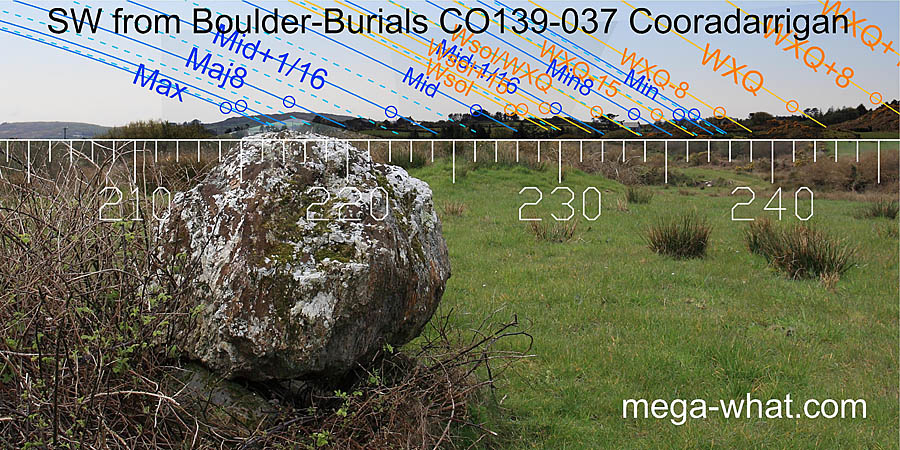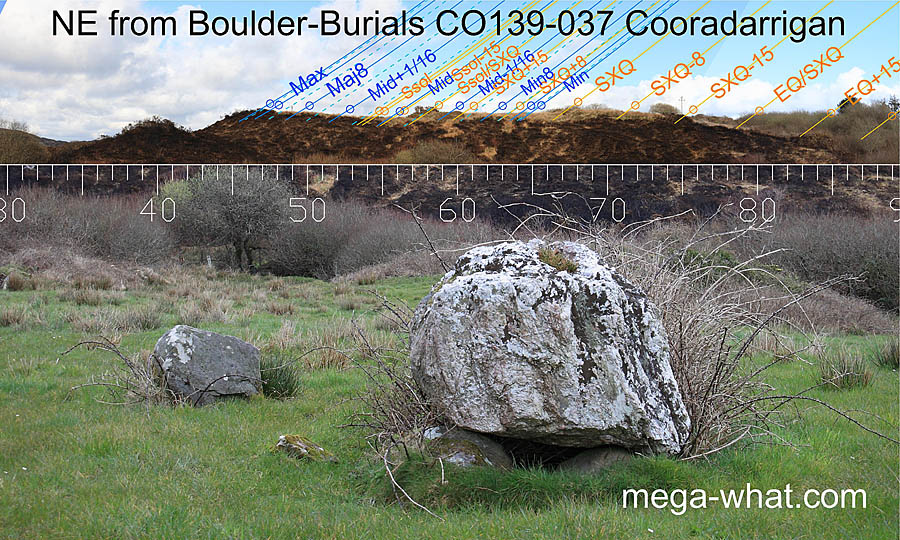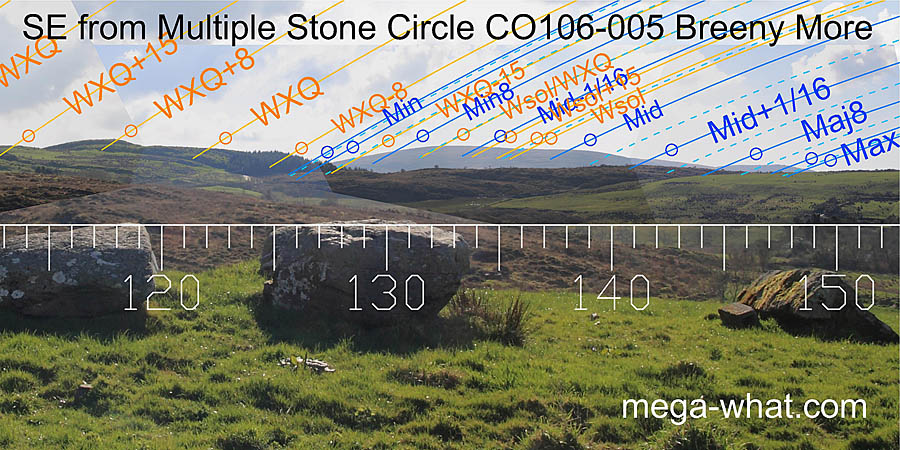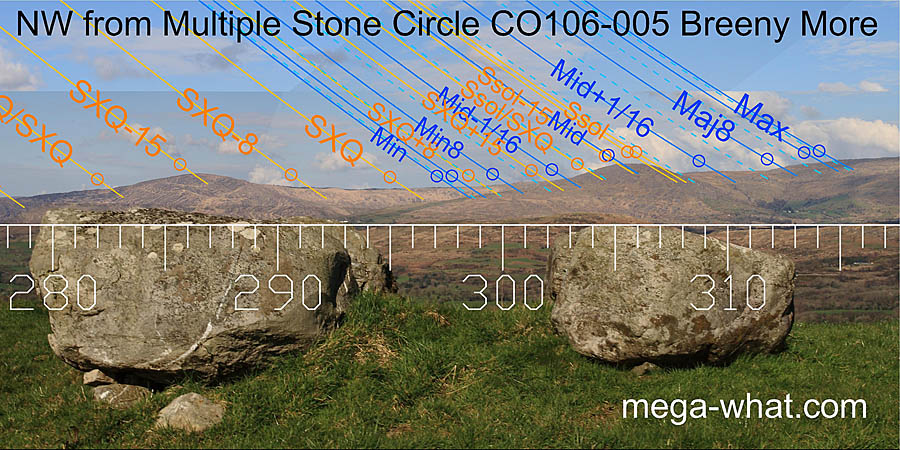Axial alignments at 18 surveyed Boulder-Burial sites.
Sorted by: Alignment Class | Location Name
Boulder-Burials are bronze age megalithic monuments associated with the Cork-Kerry Stone Circle Complex in Ireland and not found elsewhere.
Sometimes there is more than one at a site and if so they are usually close together.
- For classification purposes these surveyed horizons have been divided into a small number of zones.
This classification is an overall one that considers all axes to be potentially bi-directional.
- Extreme is where sun and moon never rise or set but excludes the north-south axis of celestial rotation.
- Lunar is where lunistices
Lunistices are the most northerly and southerly moons of the month. The lunar equivalent of solstices. More.
occur but sun rises or sets do not.
- Solar is where sun rises or sets occur but lunistices do not.
- Solar / Lunar is where a lunistice zone overlaps with the outer regions of the sun's annual travels.
Alternatively one direction may be purely solar while the other is somewhere within a lunistice range.
- Note that these terms may well have other uses elsewhere.
Axial Alignment Classes of surveyed boulder-burials
| Type | Number | %
|
|---|
| Solar | 3 | 17
|
| Solar / Lunar | 6 | 33
|
| Lunar | 5 | 28
|
| Extreme | 4 | 22
|
| North-South | - | -
|
| All | 18 | 100
|
- Boulder-burials appear to be the only monument type in the Cork-Kerry Stone Circle Complex that do not always have a north-east / south-west axial orientation.
- The ones with extreme axes seem to either bisect the space between a standstill and north-south or indicate the east & west horizons perpendicular to the long axis.
- This is not a representative sample, just the most obviously linear ones.
Of this sample (excluding the four with extreme axes), five are uni-directional and nine are bi-directional.
See for yourself:
- Orange Solar trajectories split the tropical year into 48 "Tweeks" (7.6 day mean) that are better regarded as quarter-months.
- Solid Blue Lunar lines split cyclical lunistice position variation into 16 periods of about 14 months each.
- Lunistices are the most northerly and southerly moons of the month [More].
- Also see Technical Notes on the Pictures
Class = Solar: Total 3 = 17%.
Both axial directions indicate pure solar horizons where no
lunistices
Lunistices are the most northerly and southerly moons of the month. The lunar equivalent of solstices. More.
occur, or one direction does so while the other is beyond the entire luni-solar range.
Go to class= Solar/Lunar |
Lunar |
Extreme

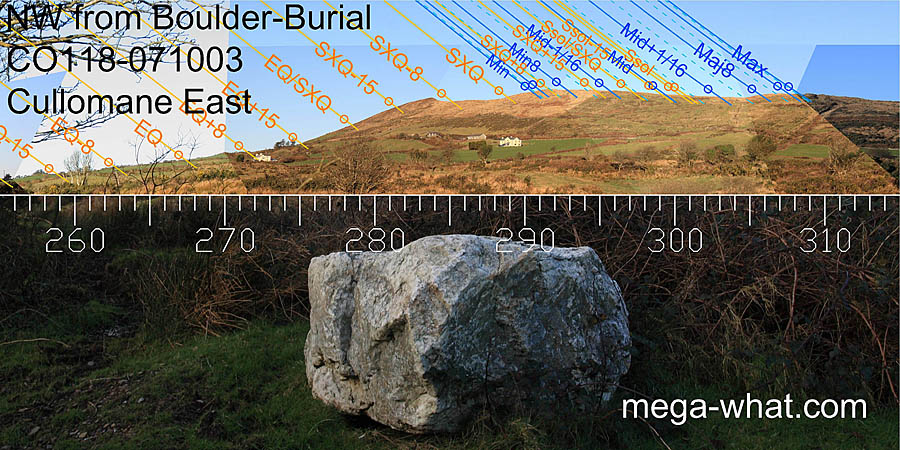 Cullomane Boulder-Burial
Cullomane Boulder-Burial:
The line from a small outlier, through the boulder to a hilltop cairn marks major standstill but
the diamond-shaped boulder indicates the south-east which is obscured.
Axial reverse indicates summer cross-quarter sunsets but the axis would be half-way between the equinox and winter cross-quarters.

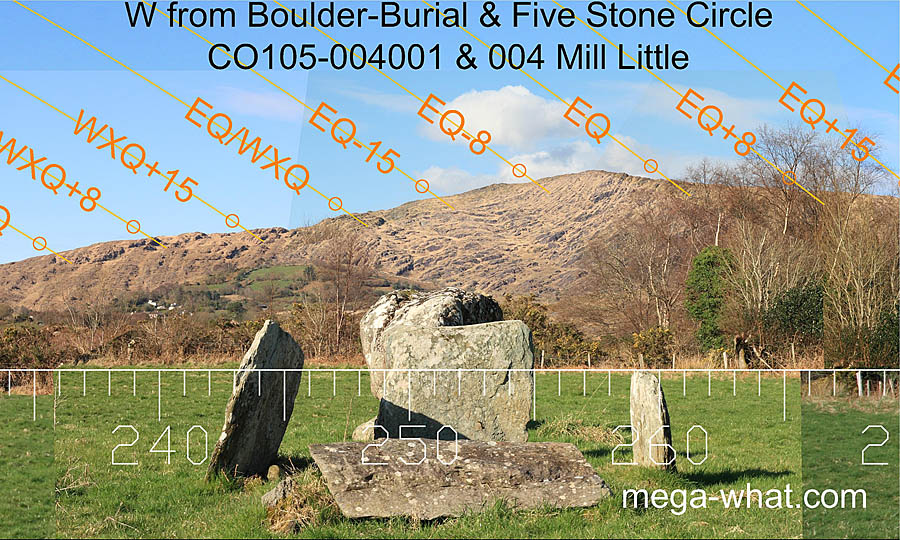 Mill Little N Boulder-Burial & Stone Circle
Mill Little N Boulder-Burial & Stone Circle:
Both boulder-burial and five stone circle indicate summer cross-quarters to the north-east.
To the west they point a week or two south of the equinox (before the spring one).
The circle's radially set portals are both broken stumps and the slab across them is field clearance.

 Oldcourt Boulder-Burial
Oldcourt Boulder-Burial:
The primary boulder is displaced. Beside it is another stone, recorded as a possible fallen standing stone.
This stone clearly indicates equinox sun rises and its reverse axis to the west is close to the equinox / cross quarter midpoint.
Almost certainly a secondary boulder-burial as at
Cooradarrigan.
Class = Solar / Lunar: Total 6 = 33%.
There are four zones, each roughly 10° wide at these latitudes, where the minor side of a
lunistice
Lunistices are the most northerly and southerly moons of the month. The lunar equivalent of solstices. More.
range overlaps with solar risings or settings.
At least one axial direction indicates one of them. If only one does so then the other may be any class. Alternatively one direction may be purely solar while the other is somewhere within a lunistice range.
Go to class= Solar |
Lunar |
Extreme

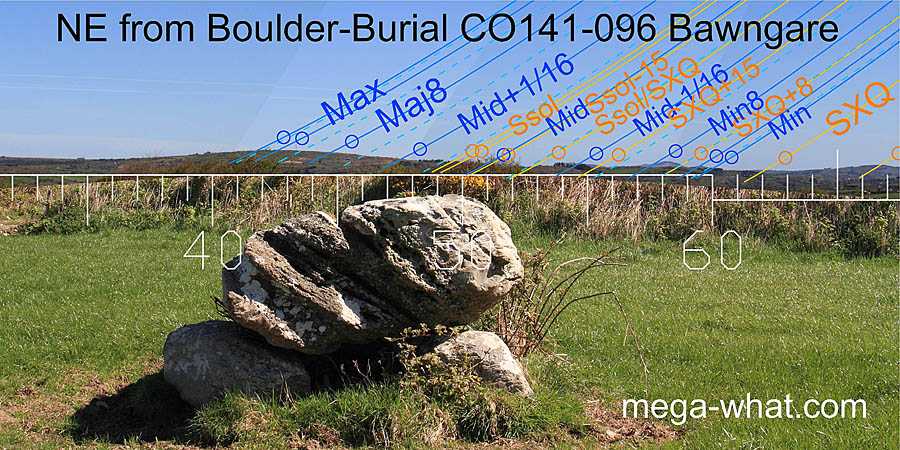 Bawngare Boulder-Burial
Bawngare Boulder-Burial:
The primary axis is to the south-west where it covers the minor half of the lunistice range. To the north-east it covers the major half.
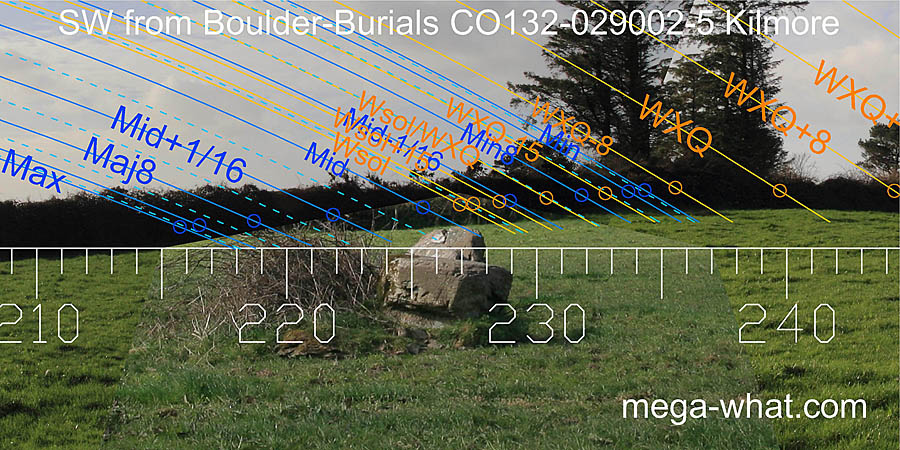
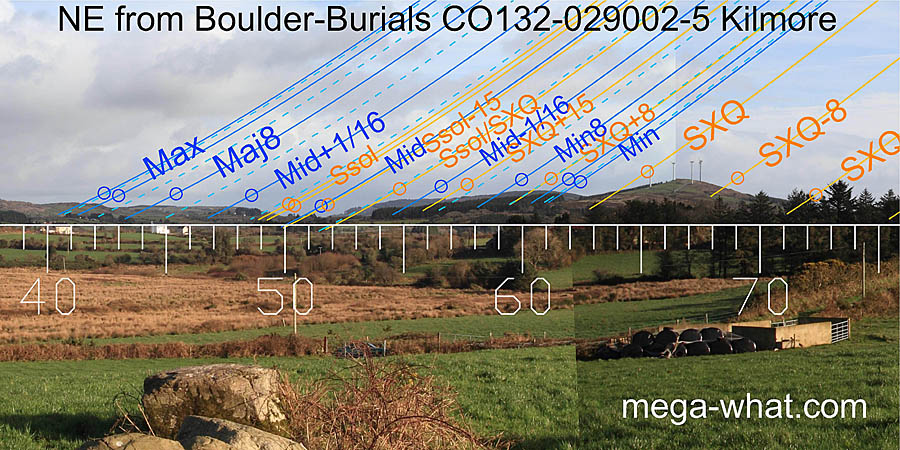 Kilmore Boulder-Burials
Kilmore Boulder-Burials:
This row of four boulders indicates winter solstice or lunar mid-cycle to the south-west. It is possible that standing on them once made a more distant view possible but it is now obscured.
To the north-east, the line is slightly beyond the solstice, towards a lunar sixteenth.
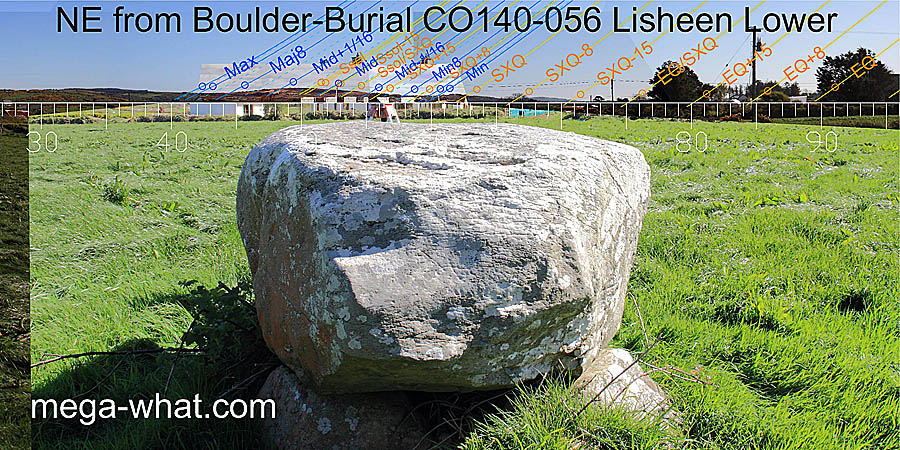
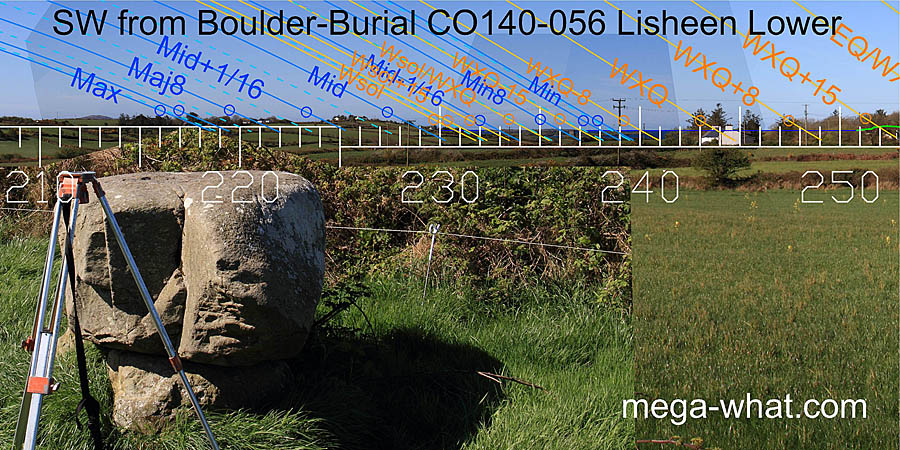 Lisheen Boulder-Burial
Lisheen Boulder-Burial:
This boulder has a long axis but the shape gives different angles.
North-eastwards it centres on the minor standstill / cross-quarter.
To the south-west it indicates the major standstill.
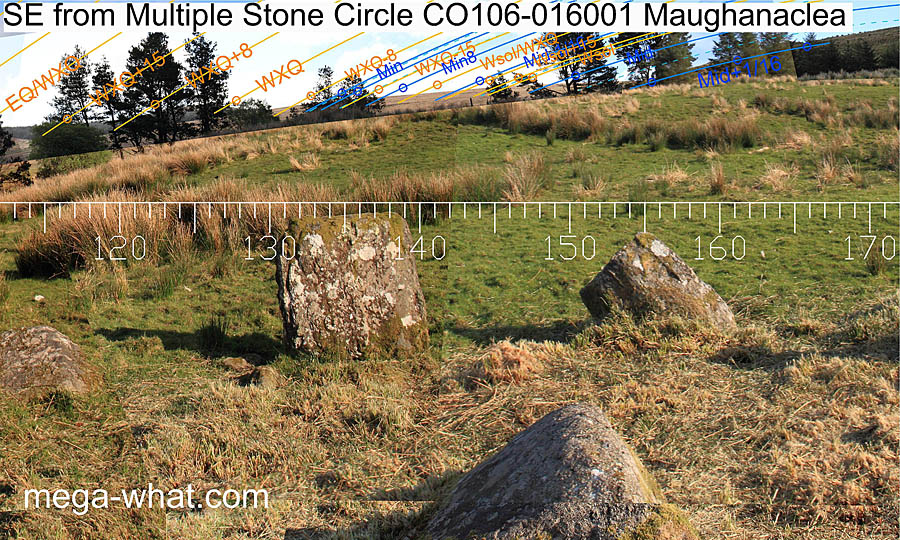
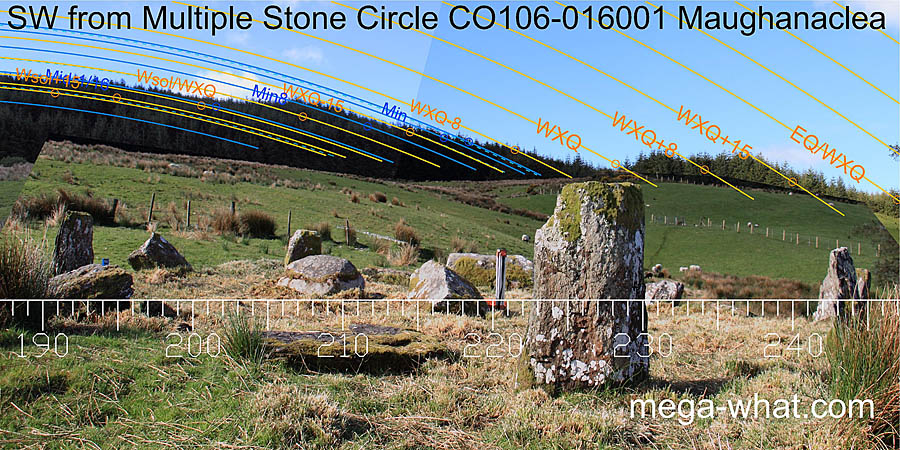 Maughanaclea Boulder-Burials
Maughanaclea Boulder-Burials:
Two boulder-burials lie within a stone circle.
The central one indicates the minor side of the south-west lunistice zone.
The other, in the south-east quadrant of the circle, points to the major side of the south-east one.
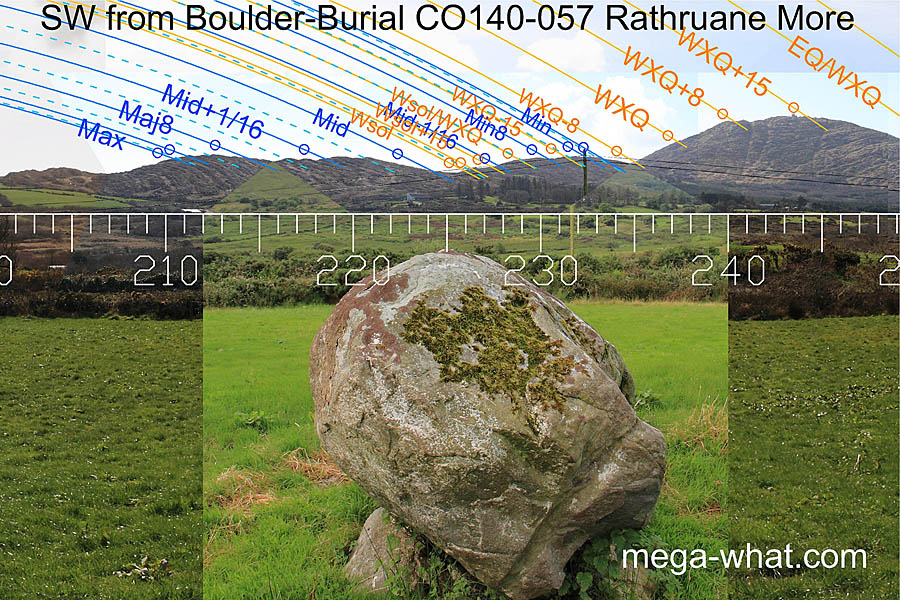
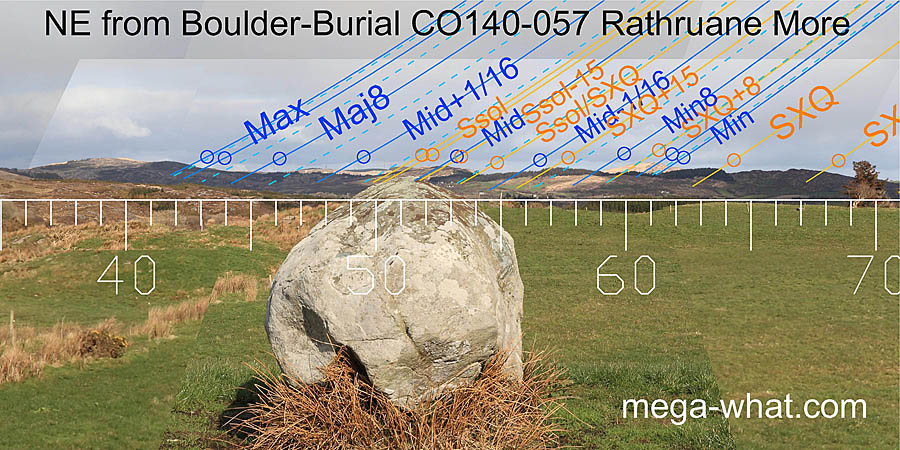 Rathruane Boulder-Burial
Rathruane Boulder-Burial:
The precise south-western axis cannot be seen due to the slope of the ground but is not important anyway because of the prominent solstitial dip.
The primary axis is to the north-east where the ridge of the boulder indicates summer solstice sun rises at a not otherwise very obvious position within a more prominently marked lunistice range.
This last one could be regarded as borderline.
Class = Lunar: Total 5 = 28%.
Both directions indicate a pure lunar zone (major side of the
lunistice
Lunistices are the most northerly and southerly moons of the month. The lunar equivalent of solstices. More.
range) or one direction does so while the other is beyond the entire luni-solar range.
Go to class= Solar |
Solar/Lunar |
Extreme
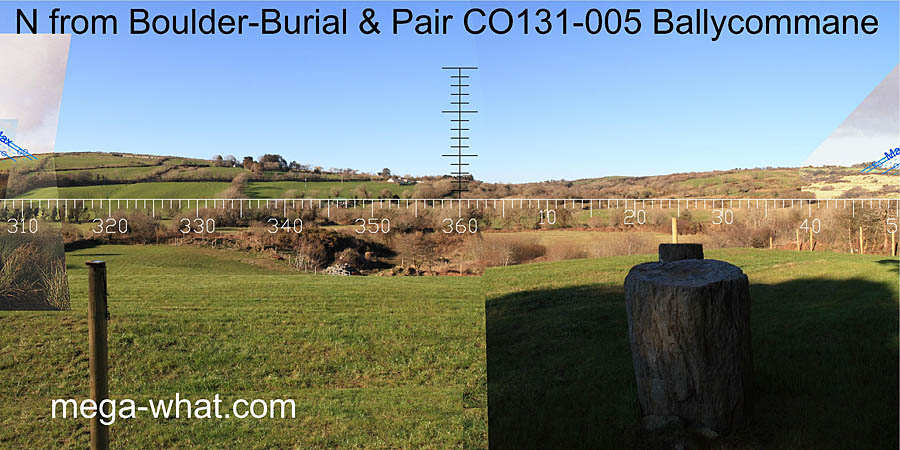
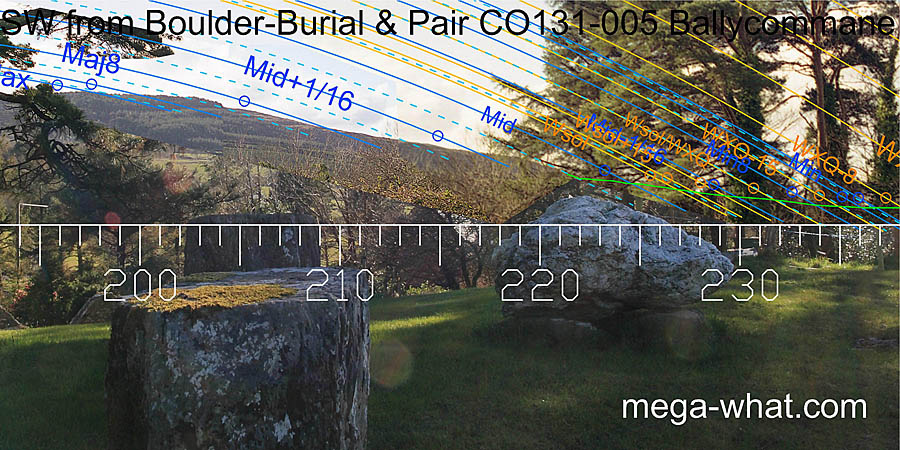 Ballycommane Stone Pair (& Boulder-Burial)
Ballycommane Stone Pair (& Boulder-Burial):
The axis of this stone pair roughly bisects the space between north and north-eastern major standstill.
To the south-west, lunar major eighth is indicated. The boulder-burial is harder to interpret but may well indicate lunar mid cycle to the south-west while being slightly beyond major standstill to the north-east.
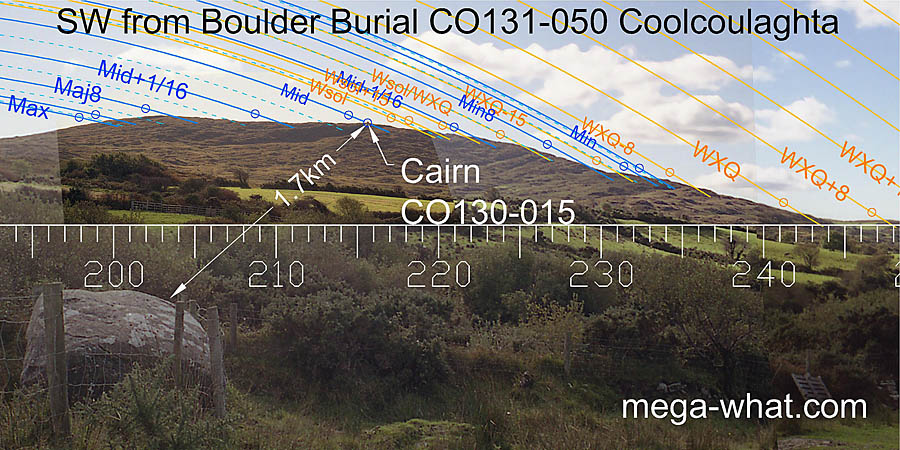
 Coolcoulaghta Boulder-Burial
Coolcoulaghta Boulder-Burial:
The axis of this rectilinear boulder is towards the south-west and the major standstill.
It is well beyond that to the north-east and the ground falls sharply away so that looking over it is not possible.

 Currakeal Boulder-Burial
Currakeal Boulder-Burial:
The boulder axis indicates major standstill to the south-west at the position of Currakeal stone row.
The reverse is not really a pointer and well beyond major standstill in any case.

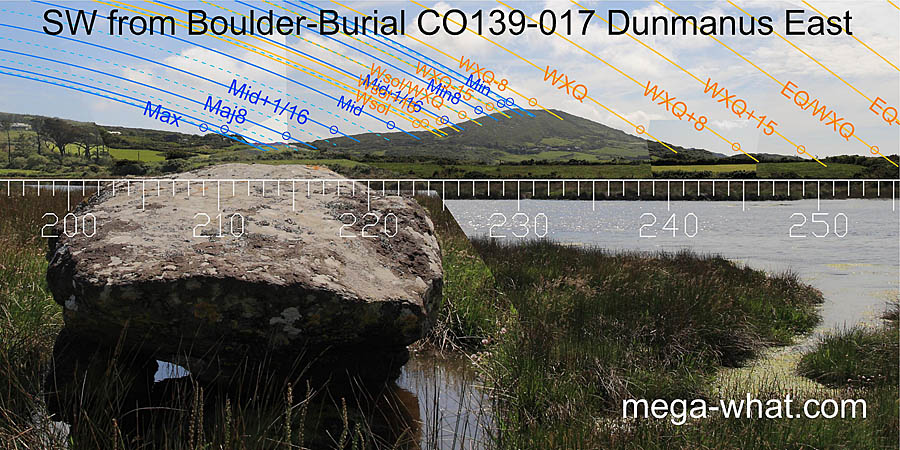 Dunmanus Boulder-Burial
Dunmanus Boulder-Burial:
The axis clearly indicates the south-west and lunar major standstill.
The reverse points beyond the north-eastern lunistice range but the standstill is above the right side of the capstone.
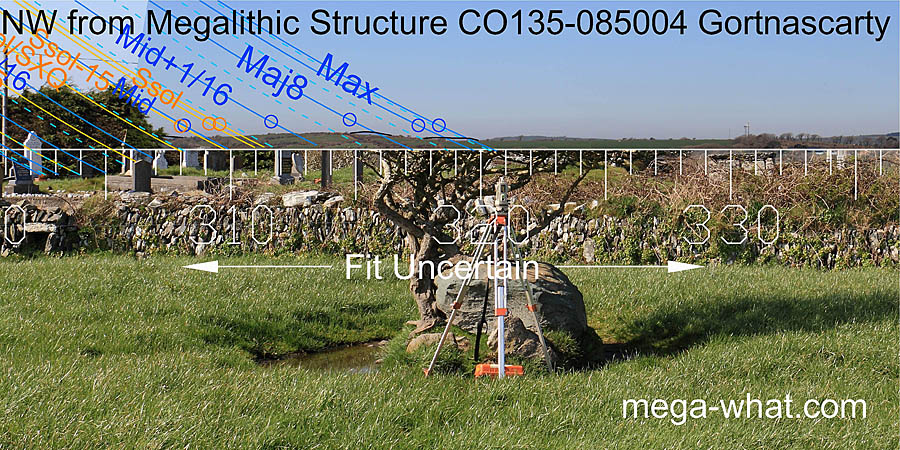
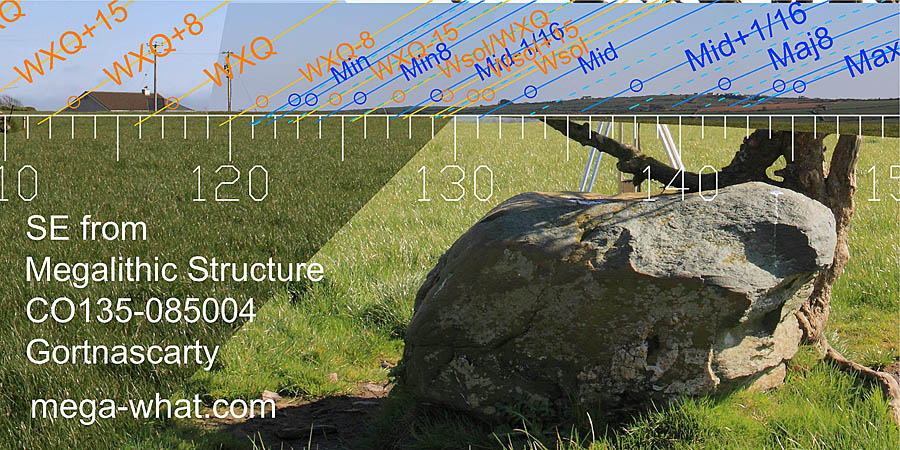 Gortnascarty Megalithic Structure
Gortnascarty Megalithic Structure:
The long axis indicates major standstill to the north-west.
To the south-east it has a broader scope, pointing at the centre of the major half of the lunistice range.
Class = Extreme: Total 4 = 22%.
Both directions indicate horizons beyond the luni-solar range and neither point north-south.
Go to class= Solar |
Solar/Lunar |
Lunar

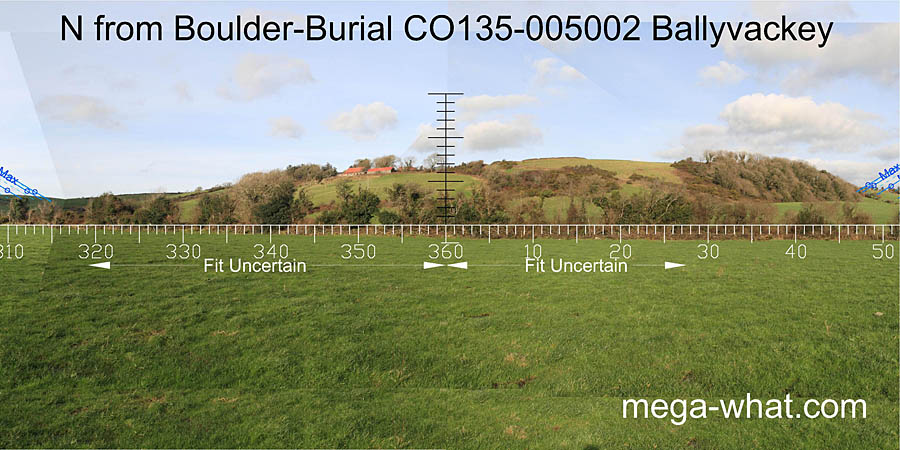 Ballyvackey Boulder-Burial
Ballyvackey Boulder-Burial:
Listed as a possible boulder-burial this one has a small standing stone at its northern end.
The long axis roughly bisects the space between south-eastern major standstill and south.
Similarly to the north-west.

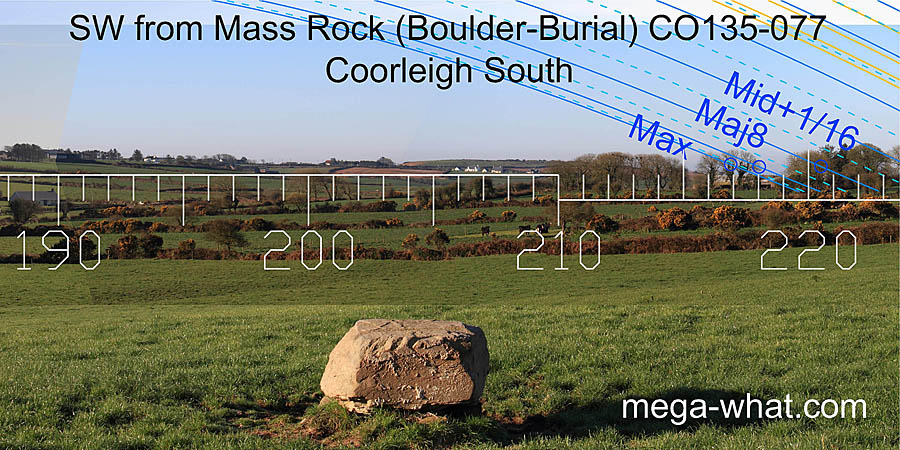 Coorleigh South Boulder-Burial / Mass Rock
Coorleigh South Boulder-Burial / Mass Rock:
The flat top is decorated with two prominent transverse grooves delimiting a central area containing perhaps thirteen cupmarks
[Pic].
The north-east axis roughly bisects the space between north and north-eastern major standstill. The south-western one is somewhat similar but slightly closer to the standstill.
The carved grooves however would seem to indicate the half-month before Samhain (to the SE) and the half-month before Lughnasadh (to the NW).

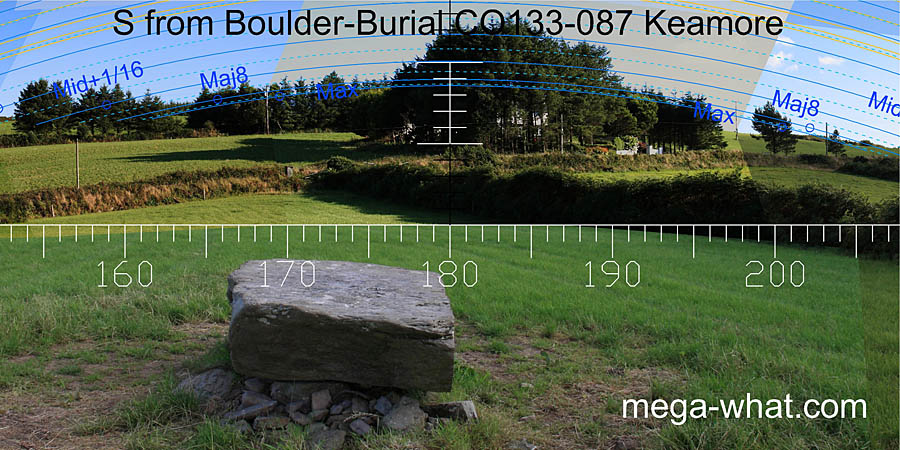 Keamore Boulder-Burial
Keamore Boulder-Burial:
The axis is about 10° anti-clockwise from north-south which
roughly bisects the space between south-east major standstill and due south.
© Michael Wilson.

















